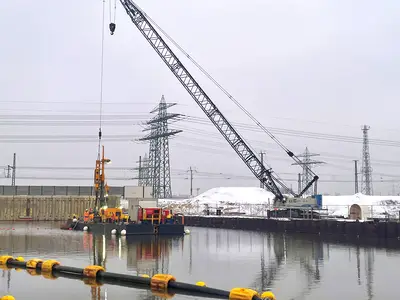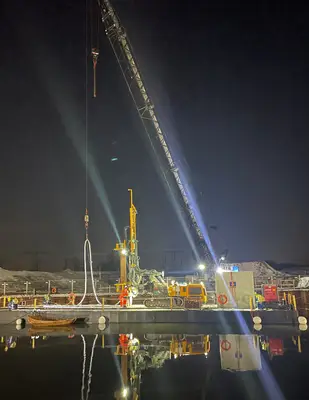Paving the way for the future: Bauer Spezialtiefbau involved in partial section of the A26 near Hamburg
Hamburg, Germany – Increasing traffic on Federal Highway 73 for a number of years now, heavy traffic loads on adjacent side roads and auxiliary roads, high accident figures and growing impact on residents due to exhaust gases and noise: these are just several of the reasons for the expansion of the highway network to the south and west of Hamburg. In the future, the new A26 will establish a connection between the Hanseatic city of Stade and the north-south Highway A7 to the south of Hamburg. The subsequent expansion of the A26 in the eastbound direction to the A1 aims to close the current gap in interregional east-west traffic between Lübeck, Hamburg and Cuxhaven.
Enormous infrastructure project
An initial section of the A26 from Stade to the state border between Lower Saxony and Hamburg has already been completed and is open for traffic. The A26 West, known as section 4 of the A26, is currently under construction to establish the pending 8 km connection from the state border of Lower Saxony to the A7. The joint venture “Hafenbahntunnel Hamburg”, comprising August Reiners Bauunternehmung GmbH and BAUER Spezialtiefbau GmbH, was contracted by the company Deutsche Einheit Fernstraßenplanungs- und -bau GmbH (DEGES) for lot 4.2. For this project, a tunnel will be constructed using the trough method below the dam of the harbor railway, which operates as a freight-only route for loading and unloading shipments to the port of Hamburg by rail. The goal is to construct four lanes of the A26 up to the new motorway junction HH-Hafen ("Port of Hamburg").
Challenging project
The two construction sections of the project are divided into a west and east side by the harbor railway freight route. In both sections, soil improvements are being carried out using geotextile-encased sand columns. These will stabilize the construction soil in order to build the trough pits and the future traffic routes. In addition, pile walls and anchoring for sheet pile walls are also being constructed. The uplift anchors for an underwater concrete slab are currently being executed, along with preparatory work for pumping water out of the excavation pit. A BG 30 drilling rig from Bauer, an RG 25 pile driver and a KLEMM KR 806-3GS anchor drilling rig are in use for these tasks. “All work has to be carried out while the railway line continues operation,” explains Andreas Wedenig, Project Manager at Bauer Spezialtiefbau. “Furthermore, the soil conditions are highly complex, as the site is located in a peat bog zone.” Additional challenges are posed by the limited work height due to overhead line masts and three high-voltage power corridors directly over the construction site, as well as the challenge of ensuring uplift prevention from pontoons.
Digital tools as the key to success
A variety of digital tools are used for the work. “For the execution of geotextile-encased sand columns and pile walls, we use our in-house data management software b-project for digital collection, linking, and evaluation of all relevant quality and process data generated when handling a project,” continues Andreas Wedenig. When monitoring the anchor load using IoT-networked anchor load measurement cells, problems were identified with the soil composition of the dam. A solution was found by reviewing the structural design and developing a new concept for the fixing force. Andreas Wedenig: “Collecting all data in our digital tools facilitates collaboration as a team, reduces complexity and enables more effective work.” The specialist foundation engineering work started in November 2021 and is expected to be completed by September 2026.


